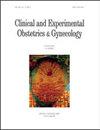增加颈部透明度和胎儿结局:泰国一项基于人群的研究
IF 0.4
4区 医学
Q4 OBSTETRICS & GYNECOLOGY
引用次数: 0
摘要
背景:确定泰国人群中颈部半透明性(INT)增加与胎儿结局之间的关系。方法:访问胎儿唐氏综合症筛查项目的前瞻性数据库,以检索任何有NT测量记录的女性的记录。所选妊娠分为INT组(>95%)和正常组(<95%)。NT对唐氏综合征和血红蛋白Bart病的预测效果也得到了确定。比较妊娠结局,同时使用多变量分析来纠正主要混杂因素。结果:在记录的8225次NT测量中,7126名胎儿的数据可供分析。其中,INT组357例,正常组6769例。INT与Turner综合征、Down综合征、Edwards综合征、Patau综合征、心脏缺陷和Hb Bart病显著相关。排除胎儿异常后,INT组的流产率、低出生体重(LBW)率、早产率和宫内死亡(IUD)率显著较高,调整后的比值比(95%CI)分别为7.82(7.48-13.66)、0.60(0.42-0.86)和5.10(1.11-23.42)。INT对唐氏综合征的预测有效,敏感性为61.1%,假阳性率为5%。结论:INT除了能有效筛查非整倍体和心脏缺陷外,还能显著提高某些特定地理区域疾病的风险识别,例如泰国的Hb Bart病。在本研究中的整倍体胎儿中,流产率、LBW、早产率和宫内节育器也显著增加。本文章由计算机程序翻译,如有差异,请以英文原文为准。
Increased nuchal translucency and fetal outcomes: a population-based study in Thailand
Background: To determine the association between increased nuchal translucency (INT) and fetal outcomes among Thai population. Methods: A prospective database of fetal Down syndrome screening project was accessed to enable retrieval of the records of any women with recorded NT measurements. The selected pregnancies were categorized into the INT group (>95th percentile) and the normal (<95th percentile) group. The effectiveness of NT for prediction of Down syndrome and hemoglobin Bart's disease was also determined. Pregnancy outcomes were compared, also using multivariate analysis to correct the major confounders. Results: Out of 8225 NT measurements recorded, data from 7126 fetuses were available for analysis. These included 357 in the INT group and 6769 in the normal group. INT was significantly associated with Turner syndrome, Down syndrome, Edwards' syndrome, Patau syndrome, cardiac defect and Hb Bart's disease. After exclusion of fetal abnormalities, rates of abortion, low birth weight (LBW), preterm birth and intrauterine death (IUD) were significantly higher in the INT group, with adjusted odds ratio (95% CI) of 7.82 (7.48–13.66), 0.60 (0.42– 0.86) and 5.10 (1.11–23.42), respectively. INT was effective in predicting Down syndrome with a sensitivity of 61.1% with a false positive rate of 5%. Conclusions: In addition to effectiveness in screening aneuploidy and cardiac defect, INT significantly increased the identification of risk of some diseases specific to a certain geographical area, for example Hb Bart's disease in Thailand. Among the euploid fetuses in this study the rate of abortion, LBW, preterm birth and IUD were also significantly increased.
求助全文
通过发布文献求助,成功后即可免费获取论文全文。
去求助
来源期刊
CiteScore
0.50
自引率
0.00%
发文量
241
审稿时长
1 months
期刊介绍:
CEOG is an international, peer-reviewed, open access journal. CEOG covers all aspects of Obstetrics and Gynecology, including obstetrics, prenatal diagnosis, maternal-fetal medicine, perinatology, general gynecology, gynecologic oncology, uro-gynecology, reproductive medicine, infertility, reproductive endocrinology, sexual medicine. All submissions of cutting-edge advances of medical research in the area of women''s health worldwide are encouraged.

 求助内容:
求助内容: 应助结果提醒方式:
应助结果提醒方式:


